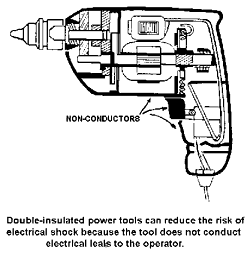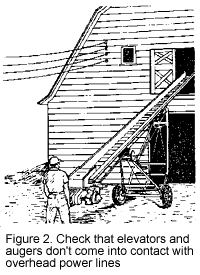Since the 1930's, electrical service has been brought to virtually ever rural area of the state and has increased the productivity of the Michigan farmer. Electricity has proven invaluable to the Michigan farm industry; but some rural farmers have found that if improperly used it can be the source of fires, injuries, and even death.
Electrical hazards on the farm can: result in electrical shock to humans or to livestock and possibly result in a fire within structures or in operating equipment.
Risks associated with electrical hazards on the farm are increased by the presence of moisture, especially by the dampness that is common in confined livestock areas.
Animals are naturally grounded, making them more sensitive to low intensity electrical currents than humans. Humans have dryer skin than animals and normally wear shoes or boots which provide greater resistance to electrical shock. Humans usually will not feel an electrical shock from stray current that a well-grounded animal does when standing on a damp concrete slab or damp ground.
Animals experiencing even a minor electrical shock may be reluctant to drink from a waterer. On a dairy farm, for example, this reduced water intake may result in less milk production and a financial loss to the farmer.
REDUCING ELECTRICAL HAZARDS

GROUND-FAULT CIRCUIT INTERRUPTERS (GFCI)
The GFCI works on the principle that the two wires supplying a single-phase electrical load must carry the same number of amperes (current) when the circuit is operating properly. If a ground-fault occurs either to the grounding wire, or through a person or animal, some of the current will take an alternate route back to the system's grounding electrode. One of the wires will then carry less current than the other wire. When this occurs the GFCI will break the circuit, stopping the flow of electricity in a fraction of a second to reduce the electric shock hazard.
Ground-fault circuit interrupters come in several styles. They are commonly used as a receptacle outlet, part of an extension cord, or can be installed in the main electrical panel to replace an existing circuit breaker. When installed as a circuit breaker, the GFCI offers shock protection to an entire electrical branch.
Ground-fault circuit interrupters are available for 120-V circuits with one hot wire and a neutral. A GFCI will work on older two-wire electrical systems that have no ground wire. A 120-V, single-pole GFCI fits into the same size space as a standard single-pole breaker. There are also GFCIs for 240-V circuits using two hot wires.
All equipment plugged into a GFCI protected receptacle, including any two-prong (two-wire) electrical plug, will have ground-fault protection.
A portable GFCI is recommended for persons using power tools in damp or wet locations. The portable GFCI is plugged into an outlet and the power tool is plugged into the GFCI.
Certain conditions can result in "nuisance tripping" of a GFCI protected circuit or receptacle.
Nuisance tripping can be reduced by avoiding:
Installing a GFCI to prevent electrical shock from farm equipment seems like a good idea, but nuisance tripping may become a serious problem. The loss of a ventilation system in certain livestock facilities can be fatal to animals. Stock waterers may freeze in northern climates if the GFCI trips. Carefully consider the effects of loss of power to an agricultural circuit before installing GFCI protection. The most effective shock prevention system for agricultural equipment and circuits is a good equipment grounding conductor run with the circuit wires and connected to all metal agricultural equipment.
EXTENSION CORDS
OTHER ELECTRICAL HAZARDS ON THE FARM
 Moving a grain auger in the elevated position may electrocute
someone if it comes into contact overhead power lines. Anyone
moving an auger should lower it first. Check the height of all
tall equipment to ensure that it will not touch overhead powerlines
during the move. Recently manufactured augers should have a
warning label attached that indicates DANGER, Electrocution
Hazard. Follow safety warnings (see Figure 2).
Moving a grain auger in the elevated position may electrocute
someone if it comes into contact overhead power lines. Anyone
moving an auger should lower it first. Check the height of all
tall equipment to ensure that it will not touch overhead powerlines
during the move. Recently manufactured augers should have a
warning label attached that indicates DANGER, Electrocution
Hazard. Follow safety warnings (see Figure 2).
Mechanical Damage to Electrical Wiring Problems can occur when using or moving equipment inside buildings if wiring is not securely fastened and protected. Interior wiring should also be protected from animal damage by encasing it in metal or plastic conduit or by elevating the wiring above the animals' reach.
"UF" vs. "NM" Type Electrical Wiring Type UF cable wiring is rated for dry, damp, wet, or corrosive locations. This type cable is permitted for surface and concealed wiring in buildings, and for direct burial in the earth. It may not be embedded in poured concrete.
Exercise care if electrical conduit is used. Moist and extremely corrosive conditions may quickly destroy metal conduit. Animals may chew nonmetallic conduit or it may become damaged by impact from animals or machines. Check installations frequently and be prepared to replace damaged conduit or cable.
Type "NM" wire should not be buried because of the potential damage from moisture. Type "NM" electrical wire is not generally recommended for agricultural environments associated with animals or damp areas. Consult an electrician for specific applications or recommendations for your farm wiring concerns.
Electrical Fires in Agricultural Machinery Electrical malfunctions in machinery can be a fire hazard. Combines can be a particular problem because of the grain fines and crop residues that are readily combustible. Check a combine's hydraulic and fuel systems for leaks, and inspect all electrical components, including battery terminal connections, for proper operation before the harvest season and at least weekly during harvesting. Shut off the machine as quickly as possible if a fire is suspected. Turn off the ignition and remove the key to prevent electrical current flow to the area of the fire and to prevent someone else from restarting the engine.
If an Accident Involving Electrical Shock or Fire Occurs Could You...?
To eliminate confusion, have a complete set of directions available to instruct emergency crews to the farm site.
Keep the telephone number of the fire department and other emergency services posted near the telephone to avoid any delay in reporting an emergency.
REFERENCES
Michigan State University, Agricultural Engineering Department.
Howard J. Doss, Cornita Tilma, Agricultural Safety Specialist and former Graduate research assistant respectively, Michigan State University Extension, East Lansing, Michigan 48824. 5/92. Funded by the National Institute of Occupational Safety and Health -
Disclaimer and Reproduction Information: Information in NASD does not represent NIOSH policy. Information included in NASD appears by permission of the author and/or copyright holder. More